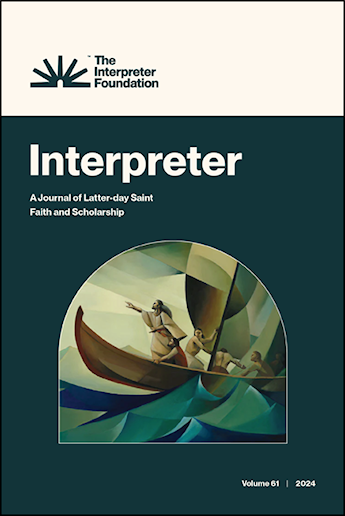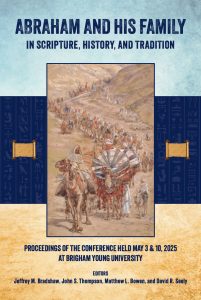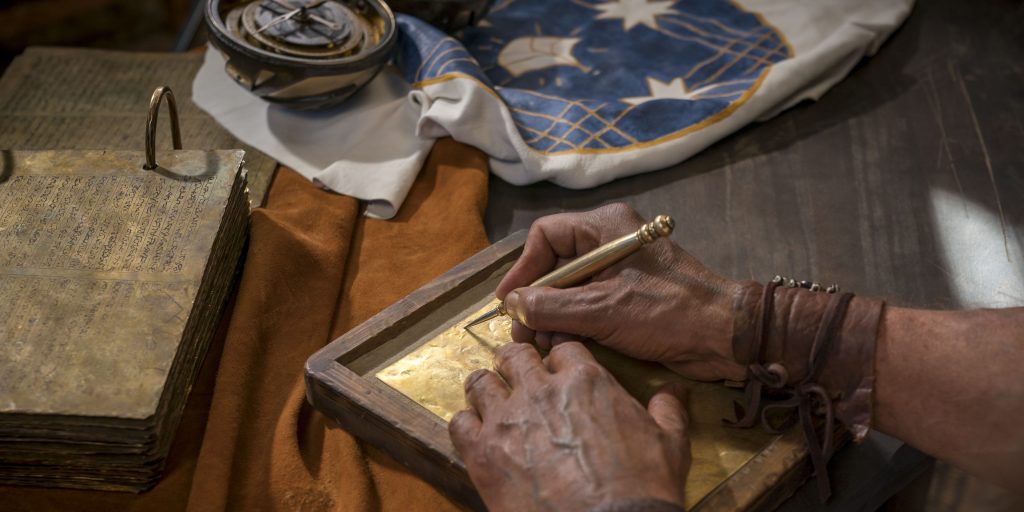[Page 17]Abstract: The double negative phrase “forbiddeth to abstain” as found in D&C 49:18 can be confusing and syntactically challenging for readers. While some have argued that the phrase should be read and understood literally, the Doctrine and Covenants of The Church of Jesus Christ of Latter-day Saints indicates that a literal reading is not correct. In this article I demonstrate that the phrase “forbid to abstain” was an accepted English idiom prior to and for a few decades following the receipt of D&C 49, even though it has vanished from contemporary usage completely. The meaning of this idiomatic expression was “command to abstain,” in opposition to its literal meaning. The probable origin of this expression is the Greek text of 1 Timothy 4:3, which in English partially reads “commanding to abstain from meats.” However, in Greek the phrase “commanding to abstain” would be rendered more correctly as “forbidding to abstain.” I conclude that the proper reading of “forbiddeth to abstain” in D&C 49:18 is the idiomatic rather than the literal one and that it should be understood as “commandeth to abstain.” Continue reading
 Welcome to Interpreter: A Journal of Latter-day Saint Faith and Scholarship, the peer-reviewed journal of The Interpreter Foundation, a nonprofit, independent, educational organization focused on the scriptures of The Church of Jesus Christ of Latter-day Saints. Non-print versions of our journal are available free of charge, with our goal to increase understanding of scripture. Our latest papers can be found below.
Welcome to Interpreter: A Journal of Latter-day Saint Faith and Scholarship, the peer-reviewed journal of The Interpreter Foundation, a nonprofit, independent, educational organization focused on the scriptures of The Church of Jesus Christ of Latter-day Saints. Non-print versions of our journal are available free of charge, with our goal to increase understanding of scripture. Our latest papers can be found below.
Interpreter's Mission Statement →
Read the journal →
Learn more about the Board →
Find out how you can donate →
Contact the Editorial Board →

Church History and Great Britain with the Interpreter Foundation 14-Day Land Tour escorted by Dan Peterson, Kristine Frederickson, and Peter Fagg May 6-19, 2026 This tour will sell out fast so book your reservation now! Go to https://interpreterfoundation.org/study-travel/britains-2026/ for more information |
|
Abraham and His Family in Scripture, History, and Tradition Proceedings of the Conference held May 3 & 10, 2025 at Brigham Young University Sponsored by The Interpreter Foundation, Edited by Jeffrey M. Bradshaw, John S. Thompson, Matthew L. Bowen, & David R. Seely Published by The Interpreter Foundation and Eborn Books For more information, go to https://interpreterfoundation.org/books/abraham-and-his-family/ |
|
Call for Proposals “For a Wise Purpose in Him” Perspectives on the Small Plates of Nephi A Conference on the Small Plates of Nephi in the Book of Mormon May 29-30, 2026 Sponsored byThe Interpreter Foundation Go to https://interpreterfoundation.org/conferences/2026-small-plates-of-nephi/ for more information |
Who Was Sherem?
[Page 1]Abstract: The Book of Mormon’s first anti-Christ, Sherem, “came among” the Nephites before their first generation was ended. Because he was an eloquent believer in the Law of Moses, there has been a variety of surmise as to his background. Was he a Lamanite, or a Jaredite or Mulekite trader? Was his presence among the separated Nephites evidence of early interaction between the Nephites and other civilisations in Nephite lands from the time of their first arrival? This short article reviews the various suggestions about Sherem’s identity and suggests he was most likely a descendant of the original Lehite party but that his identity was purposely suppressed so as not to give him more credibility than he deserved. Continue reading
An Exhortation to Study God’s Two “Books”
[Page vii]From the birth of modern science at the end of the sixteenth century, Galileo famously believed that God had written two books — the scriptures and the Book of Nature. The scriptures, he contended, should be interpreted by scholars and theologians, whereas the Book of Nature was the province of scientists: Continue reading
What Command Syntax Tells Us About Book of Mormon Authorship
[Page 175]Abstract: The variety of command syntax found in the Book of Mormon is very different from what is seen in the King James Bible. Yet it is sophisticated and principled, evincing Early Modern English linguistic competence. Interestingly, the syntactic match between the 1829 text and a prominent text from the late 15th century is surprisingly good. All the evidence indicates that Joseph Smith would not have produced the structures found in the text using the King James Bible as a model, nor from his own language. The overall usage profile of command syntax seen in the Book of Mormon strongly supports the view that the Lord revealed specific words to Joseph Smith, not simply ideas. Continue reading
Christmas Is About a Baby
[Page 169]When I was a child, I completely understood all the Santa Claus stuff. No great moment of disillusionment, because my parents were wise enough to let us help create the illusion for the younger kids as soon as we were old enough.
I loved decorating the tree. I was the icicle fanatic, laying each one on individually. Even better was setting up HO trains all around the tree (and short-circuiting the train by laying icicles on the track for the engine to run over).
Shopping for gifts was great, but when I was feeling ambitious, so was creating some of the most awful “crafts” that ever forced a parent to smile and pretend to not only “love” the gift but also understand what it was supposed to be.
The Christmas carols. The church Christmas bazaar. Pretending to like candy canes. Playing games with the family. Digging treats out of the stockings. Trying to conceal my envy when my older siblings got cool gifts that my parents thought I was too young for (but they were always wrong, in my opinion).
You know: Christmas.
As a kid, I took Santa Claus in stride, but after a while I wondered about the Christ child: What was all the hoopla about? Continue reading
The Integration of Temples and Families: A Latter-day Saint Structure for the Jacob Cycle
[Page 131]Abstract: Scholars from many religious backgrounds — including Latter-day Saints — have noted both temple themes and parallel structures in the Jacob Cycle (Genesis 28-35). The present paper surveys that body of work and then offers a new structural understanding of the text, one that is uniquely LDS. This interpretation focuses on the entwining of temple and family themes in the narrative, showing how the form of the text uses each to support the other. Continue reading
Heartland as Hinterland: The Mesoamerican Core and North American Periphery of Book of Mormon Geography
[Page 111]Abstract: The best available evidence for the Book of Mormon continues to support a limited Mesoamerican model. However, Alma 63 indicates that there was a massive northward migration in the mid-first century bc. I argue that these north-bound immigrants spread out over the centuries and established settlements that were geographically distant from the core Nephite area, far beyond the scope of the text of the Book of Mormon. I introduce the Hinterland Hypothesis and argue that it can harmonize the Mesoamerican evidence for the Book of Mormon with Joseph Smith’s statements concerning Nephite and Lamanite material culture in North America. Archaeological and anthropological evidence is used to demonstrate that migrations and cultural influence did in fact spread northward from Mesoamerica into North America in pre-Columbian times. Continue reading
Cracking the Book of Mormon’s “Secret Combinations”?
[Page 63]Abstract: The Book of Mormon has been explained by some as a product of Joseph Smith’s 19th century environment. Advocates of this thesis have argued that the phrase secret combinations is a reference to Freemasonry, and reflects Joseph’s preoccupation with this fraternity during the Book of Mormon’s composition in 1828–29. It is claimed that this phrase is rarely, if ever, used in a non-Masonic context during 1828–29, and that a type of “semantic narrowing” occurred which restricted the term to Freemasonry. Past studies have found a few counter-examples, which are reviewed, but none from during the precise years of interest. This study describes many newly-identified counterexamples, including: anti-Masonic authors who use the term to refer to non-Masonic groups, books translated in the United States, legislature bills, grand jury instructions, and works which so characterize slave rebellions, various historical groups and movements, Biblical figures, and religious groups. These examples are found before, during, and after the critical 1828–29 period. Examples from 1832 onward likewise demonstrate that no semantic shift occurred which restricted secret combination to Masonry. This element of the environmental hypothesis has now been robustly disproven. Continue reading
“Most Desirable Above All Things”: Onomastic Play on Mary and Mormon in the Book of Mormon
[Page 27]Abstract: The names Mary and Mormon most plausibly derive from the Egyptian word mr(i), “love, desire, [or] wish.” Mary denotes “beloved [i.e., of deity]” and is thus conceptually connected with divine love, while Mormon evidently denotes “desire/love is enduring.” The text of the Book of Mormon manifests authorial awareness of the meanings of both names, playing on them in multiple instances. Upon seeing Mary (“the mother of God,” 1 Nephi 11:18, critical text) bearing the infant Messiah in her arms in vision, Nephi, who already knew that God “loveth his children,” came to understand that the meaning of the fruit-bearing tree of life “is the love of God, which sheddeth itself abroad in the hearts of the children of men; wherefore it is the most desirable above all things” (1 Nephi 11:17-25). Later, Alma the Elder and his people entered into a covenant and formed a church based on “love” and “good desires” (Mosiah 18:21, 28), a covenant directly tied to the waters of Mormon: Behold here are the waters of Mormon … and now, as ye are desirous to come into the fold of God … if this be the desire of your hearts, what have you against being baptized …?”; “they clapped their hands for joy and exclaimed: This is the desire of our hearts” (Mosiah 18:8-11). Alma the Younger later recalled the “song of redeeming love” that his father and others had sung at the waters of Mormon (Alma 5:3-9, 26; see Mosiah 18:30). Our editor, Mormon, who was himself named after the land of Mormon and its waters [Page 28](3 Nephi 5:12), repeatedly spoke of charity as “everlasting love” or the “pure love of Christ [that] endureth forever” (Moroni 7:47-48; 8:16-17; 26). All of this has implications for Latter-day Saints or “Mormons” who, as children of the covenant, must endure to the end in Christlike “love” as Mormon and Moroni did, particularly in days of diminishing faith, faithfulness, and love (see, e.g., Mormon 3:12; contrast Moroni 9:5). Continue reading
Looking at the Endowment and Atonement Through a Different Lens
[Page 13]A review of Blake T. Ostler, Fire on the Horizon: A Meditation on the Endowment and Love of Atonement. Salt Lake City: Greg Kofford Books, 2013, 119 pages + subject and scripture indices. Continue reading
Profound Depth in a Slender Book
[Page 9]A review of Blake T. Ostler, Fire on the Horizon: A Meditation on the Endowment and Love of Atonement. Salt Lake City: Greg Kofford Books, 2013, 119 pages + subject and scripture indices. Continue reading
Tyndale Versus More in the Book of Mormon
[Page 1]In 1526 William Tyndale’s English-language The New Testament started showing up in England, printed in the Low Lands and smuggled into England because it was an illegal book. It represented an unapproved translation of the scriptures into the English language. In theory, a translation would have been allowed if the Church had approved it in advance. In reality, the Church was not interested in any translation of the scriptures since that would allow lay readers to interpret the scriptures on their own and to come to different conclusions regarding Church practices and doctrine. Moreover, scripture formed a fundamental role in the rise of the Protestant Reformation and, in particular, Lutheranism, which King Henry VIII had officially opposed, in the governing of his realm and in his own writings in defense of the Catholic Church (for which the Church had honored him with the title of Defender of the Faith). Continue reading
Reason, Experience, and the Existence of God
[Page vii]Abstract: Both reason and experience are essential to religious life, which should be neither completely irrational nor entirely cerebral. But surely, of the two, the experience of direct and convincing revelation would and should trump academic debate, and most obviously so for its recipient. The Interpreter Foundation was established in the conviction that reasoned discussion and analysis necessarily have a place in faithful discipleship, but also in the confidence that divine revelation has genuinely occurred. The role of reason, accordingly, is a helpful one. It serves an important ancillary function. However, it does not supplant experience with God and the divine and must never imagine that it can. Academic scholarship can refine and clarify ideas, correct assumptions, defend truth claims, generate insights, and deepen understanding, but, while human inquiry sometimes creates openings for revelation, it will never replace direct divine communication. Interpreter knows its place. Continue reading
“Zion” and “Jerusalem” as Lady Wisdom in Moses 7 and Nephi’s Tree of Life Vision
[Page 281]Editor’s Note: This article is drawn from a chapter in Samuel Zinner’s new book entitled Textual and Comparative Explorations in 1 and 2 Enoch (Provo, UT: The Interpreter Foundation/Eborn Books, 2014). The book is now available online for purchase (e.g., Amazon, FairMormon Bookstore) and will be available in selected bookstores in October 2014. The other new temple books from Interpreter are also now available for purchase. Click here for more details.
The essay traces lines of continuity between ancient middle eastern traditions of Asherah in her various later Jewish, Christian, and Mormon forms. Especially relevant in Jewish texts are Lady Wisdom (Proverbs 8; Sirach 24; Baruch 3-4), Daughter of Zion (Lamentations; Isaiah); Lady Zion and Mother Jerusalem (4 Ezra), Binah in kabbalah etc. The divine feminine in the Jewish-Christian texts Odes of Solomon 19 and Shepherd of Hermas is examined, as well as in Pauline Christian texts, namely, the Letter to the Galatians and the writings of Irenaeus (Against Heresies and Apostolic Preaching). Dependence of Hermas on the Parables of Enoch is documented. The essay identifies parallels between some of the above ancient sources and traditions about Zion and other forms of the feminine divine in 19th century America, specifically in the Mormon scriptures (Moses 7 and Nephi 11). While recognizing the corporate nature of the Enochic city of Zion in Moses 7, the essay argues that this Zion also parallels the hypostatic Lady Zion of Jewish canonical and extracanonical scriptures, especially 4 Ezra. The essay also points how the indigenous trope of Mother Earth [Page 282]parallels forms of the divine feminine stretching from the ancient middle eastern Asherah, the Jewish Lady Wisdom and Shekhinah, the Christian Holy Spirit, to the Mormon Enochic Zion. Continue reading
Is Decrypting the Genetic Legacy of America’s Indigenous Populations Key to the Historicity of the Book of Mormon?
[Page 237]Abstract: The Book of Mormon claims to be an ancient record containing a summary of a now-disappeared civilization that once lived in the American continent but originated in the Middle East. DNA studies focusing on the ancient migration of world populations support a North-East Asian origin of modern Native American populations arriving through the now-submerged land-bridge that once connected Siberia to Alaska during the last Ice Age, approximately 15,000 years ago. The apparent discrepancy between the Book of Mormon narrative and the published genetic data must be addressed in lieu of generally accepted population genetic principles that are efficient in large-scale population studies, but are somewhat weak and limitative in detecting genetic signals from the introgression of DNA by small groups of outsiders into a large, and well-established population. Therefore, while DNA can definitely provide clues about the ancient history of a people or civilization, it fails to provide conclusive proofs to support or dismiss the Book of Mormon as a true historical narrative. Continue reading
A Response to Grant Palmer’s “Sexual Allegations against Joseph Smith and the Beginnings of Polygamy in Nauvoo”
[Page 183]Abstract: Grant H. Palmer, former LDS seminary instructor turned critic, has recently posted an essay, “Sexual Allegations against Joseph Smith and the Beginnings of Polygamy in Nauvoo,” on MormonThink.com. In it, Palmer isolates ten interactions between women and Joseph Smith that Palmer alleges were inappropriate and, “have at least some plausibility of being true.” In this paper, Palmer’s analysis of these ten interactions is reviewed, revealing how poorly Palmer has represented the historical data by advancing factual inaccuracies, quoting sources without establishing their credibility, ignoring contradictory evidences, and manifesting superficial research techniques that fail to account for the latest scholarship on the topics he is discussing. Other accusations put forth by Palmer are also evaluated for correctness, showing, once again, his propensity for inadequate scholarship. Continue reading
Job: An LDS Reading
[Page 127]Editor’s Note: This article is drawn from a chapter in a volume edited by David R. Seely and William J. Hamblin entitled Temple Insights: Proceedings of the Interpreter Matthew B. Brown Memorial Conference “The Temple on Mount Zion,” 22 September 2012 (Provo, UT: The Interpreter Foundation/Eborn Books, 2014). The book will be available online (e.g., Amazon, FairMormon Bookstore) and in selected bookstores in October 2014.
In response to questions arising within God, Job, described as blameless and upright, is thrust from idyllic circumstances into a dark realm of bitter experience. Three “friends” unwittingly press Satan’s case, attempting to convince Job to admit guilt. Job, however, holds on, searching for God’s face and progressing toward a transformed understanding of God and man, which is brought to strongest expression in four great revelatory insights received by Job. Finally, Job commits himself to God and man with self-imprecating oaths. After withstanding a final challenge from Elihu/Satan, Job speaks with God at the veil and enters God’s presence. Many points of contact with the temple support the thesis that the book of Job is a literary analogue of the endowment ritual. Continue reading
“What Thank They the Jews”? (2 Nephi 29:4): A Note on the Name “Judah” and Antisemitism
[Page 111]The Hebrew Bible explains the meaning of the personal and tribal name “Judah”—from which the term “Jews” derives—in terms of “praising” or “thanking” (*ydy/ydh). In other words, the “Jews” are those who are to be “praised out of a feeling of gratitude.” This has important implications for the Lord’s words to Nephi regarding Gentile ingratitude and antisemitism: “And what thank they the Jews for the Bible which they receive from them?” (2 Nephi 29:4). Gentile Christian antisemitism, like the concomitant doctrine of supersessionism, can be traced (in part) to widespread misunderstanding and misapplication of Paul’s words regarding Jews and “praise” (Romans 2:28-29). Moreover, the strongest scriptural warnings against antisemitism are to be found in the Book of Mormon, which also offers the reassurance that the Jews are still “mine ancient covenant people” (2 Nephi 29:4-5) and testifies of the Lord’s love and special concern for them. Continue reading
The Māori Stairway to Heaven
[Page 97]A review of Jason Hartley. Ngā Mahi: The Things We Need to Do; The Pathway of the Stars. n.p.: Xlibris, 2013. 264 pp., no index. $23.00AUD (softcover).1
Jason Hartley’s book manifests a passion for alleviating the problem of Māori surging into the prisons of Aotearoa/New Zealand2 by restoring their old, traditional religious ethos and the social control that hinges on the recovery of the old belief that they are potentially noble children of God. In setting out his own disappointing discovery of the roots of both a growing problem and what he believes is the solution, he describes how he came to learn the arcane moral teachings, or old stories, that once buttressed Māori social order. For Latter-day Saints, he also demonstrates that for some Māori, despite much degradation, the Heavens are still open, just as they were when Latter-day Saint missionaries first encountered a people prepared for them and their message by their own seers, thus also implicitly challenging recent efforts to downplay or explain away the old stories as mere embellishments, wishful thinking, or an implausible founding mythology. Continue reading
Axes Mundi: Ritual Complexes in Mesoamerica and the Book of Mormon
[Page 79]Places are made sacred through manifestations of the divine or ritual activity. The occurrence of a theophany or hierophany or the performance of particular rituals can conceptually transform a place into an axis mundi, or the center of the world. A variety of such axes mundi are known from the archaeological record of Mesoamerica and the text of the Book of Mormon. I compare and contrast several distinctive types of such ritual complexes from Mesoamerica and the Book of Mormon and argue that they served functionally and ideologically similar purposes. Continue reading



 Conference Proceedings are now available
Conference Proceedings are now available